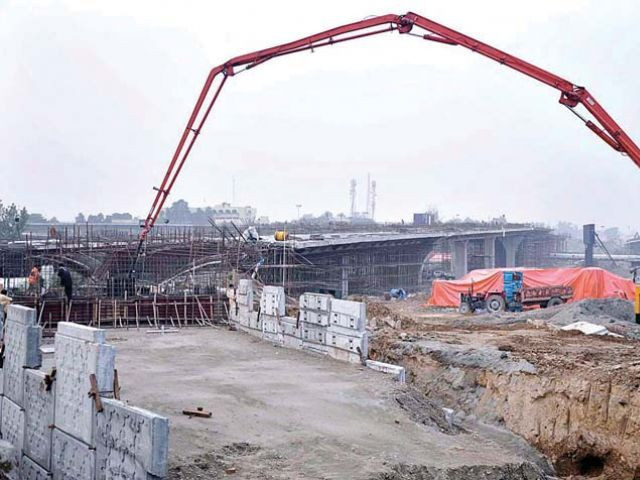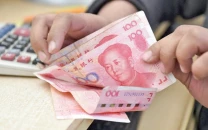Mega projects need to have mega economic returns
Question arises over CPEC-related projects’ worth to Pakistan

PHOTO: APP
They also provided a fundamental input for industrialisation — low cost, sustainable and reliable electricity. These were largely funded by the World Bank project loans, under the Indus Basin Treaty. In today’s terms, it would have been a $75 billion investment.
Pakistan to set up first mega nuclear power plant: Ahsan Iqbal
The Tarbela-Mangla complex has generated positive economic returns, many times over. Tarbela-Mangla complex was Pakistan’s first mega project. It was a game changer, rather in modern political lingo, a true fate changer.

More recently, the new acclaimed fate changer is the China Pakistan Economic Corridor (CPEC), with its promised $46 billion, of which $35 billion are meant for electricity generation.
These will be mostly coal-fired projects, at the guaranteed return of 27% and hence will be producing expensive electricity. Will the CPEC power projects be able to produce comparable economic returns for the economy? Will they match, to some degree, the mega projects of Tarbela–Mangla complex?
There are fundamental differences between the two mega projects. Tarbela-Mangla was about water, which we had plenty and still do if we can manage. According to noted economist Dr Salman Shah, during the 21 days of 2010 floods, we wasted water enough to sustain the economy of the size of California for a year. California is the world’s eighth largest economy.
CPEC is about coal, which we will need to import for this purpose, despite having large reserves of our own.
The politics of Tarbela-Mangla was largely consensual; the politics of CPEC is largely divisive with its East West route debate.
The CPEC power sector projects, once fully functional, will create external annual liability of $5 to $6 billion. It is clear that it will not be a public debt in strict sense, and largely a private investment outflow but it will be obviously a significant new pressure on foreign exchange reserves.
In that sense, a long term non-commercial loan such as the one we contracted for Tarbela-Mangla could have been much cheaper. For CPEC to produce positive economic returns, the utilisation of 10,000 megawatts of electricity they will produce, in an optimistic scenario, will have to be utilised by high value industry. These high value industries are usually high tech industries, for which the electricity cost is a relatively minor input cost. Our current industrial mix is low tech in the broadest sense. We are still a resource driven economy, a far fetch from the modern knowledge-led economies.
For CPEC produced electricity to be useful, in terms of positive economic returns, we will need to lay down an entirely new industrial infrastructure. The current shortage of electricity will already be met by improving the level of production and distribution. In Karachi, the industrial capital of the country, which caters for 70% of our industrial output, this shortage is something of a past- a fait accompli by the privatized K-Electric, a resounding success story of privatisation. There is no more load shedding for Karachi’s industries. In such scenario, who will be the buyers of CPEC electricity?
Understandably, it is always an energy mix and hence, CPEC will just be a new array of IPPs in the national grid. But for the sake of understanding, we need to ask this fundamental question: will our new industry be ready to buy electricity when CPEC IPPs will be operational?
The Board of Investment has recently prepared a list of economic zones which will be built in CPEC zones. But how much time will it take to build these new zones and to populate them is a very big question. Pakistan already has around 90 industrial zones, which are heavily under-utilised and under-populated.
Hoarding of raw material: CPEC projects cost may shoot up, PAC told
In the CPEC context, as far as Pakistan’s economic, and hence national, interests are concerned, the road connection is the easiest part. The sources at Frontier Works Organisation claim that some sections of the CPEC’s Western alignment are already complete. However, no one has a clue of what industrial infrastructure could be built around it? How much industry have we developed along the M-2 — the Lahore-Islamabad Motorway — in the last 20 years? The fishing village of Gwadar will take several decades to show signs of a commercial port city, only when we really set ourselves for that end. Current Gwadar vision is largely strategic.
High tech industry with reasonable job-absorption capacity is needed to justify the loans and investment in CPEC, without which its economic returns will be most likely in the accounting red zone when we construct our national balance sheet. These are not the signs of changing fate of a nation that will use the success stories from the mega projects of Tarbela and Mangla as benchmarks to evaluate CPEC.
The writer is founder and executive director of PRIME Institute, Islamabad
Published in The Express Tribune, April 4th, 2016.
Like Business on Facebook, follow @TribuneBiz on Twitter to stay informed and join in the conversation.



















COMMENTS
Comments are moderated and generally will be posted if they are on-topic and not abusive.
For more information, please see our Comments FAQ